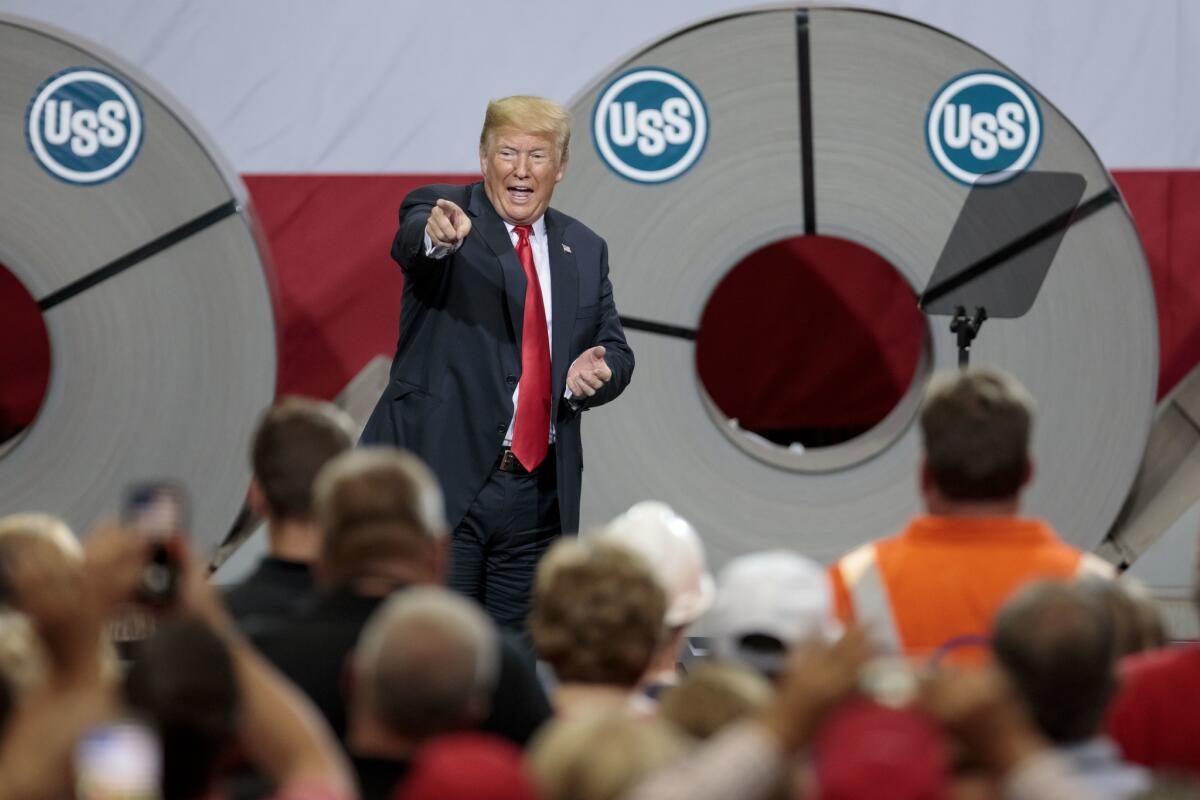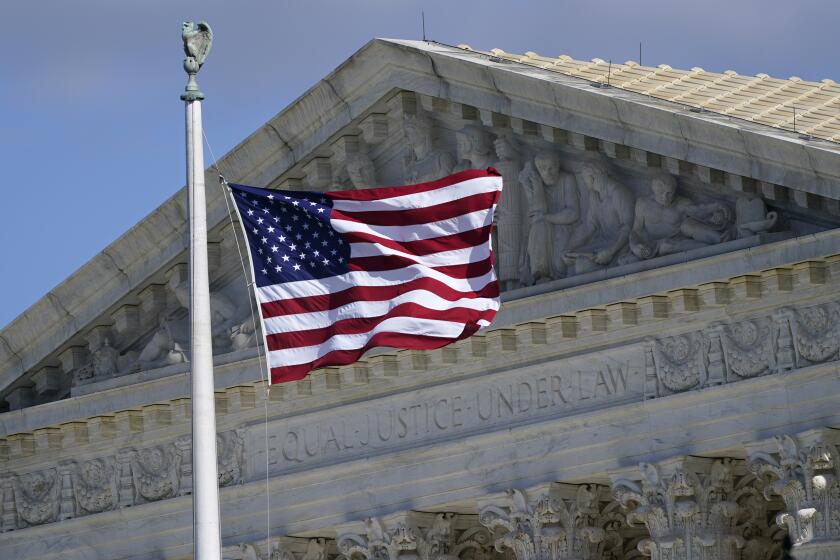Trump’s steel tariffs were supposed to save the industry. They made things worse

- Share via
WASHINGTON — When President Trump slapped 25% tariffs on foreign steel in March 2018, panicky U.S. buyers rushed to place new orders ahead of feared supply interruptions, driving prices up sharply.
It was an instant bonanza for domestic steel producers. With much fanfare, some announced ambitious expansion plans. United States Steel Corp. even fired up a pair of long-idled blast furnaces in Granite City, Ill., and Trump seized the occasion to deliver a rousing speech at the plant about the industry’s resurgence.
What a difference a year has made. Benchmark steel prices have fallen well below their level before the tariffs took effect and are now about half their peak in July 2018. The industry has responded with production cutbacks.
And while that Granite City smelter is still operating, Pittsburgh-based United States Steel has begun laying off scores of workers at two other old blast furnaces, near Detroit and in East Chicago, Ind. Several other steelmakers are closing mills, idling employees or cutting back work hours, in Louisiana, Kentucky, West Virginia and Pennsylvania. Overall employment at steel mills is little changed from two years ago.
It’s a potential political problem as well for Trump, who won office in 2016 on a promise to help revive American manufacturing and its blue-collar workers.
The root of the steel problem is a perfect storm that leaders of the American industry, prodded by Trump’s policies, created for themselves, their companies and their employees.
Emboldened by tariffs, the president’s pro-business rhetoric and tax cuts that poured money into corporate coffers, steel companies went on a spending spree that added production capacity to a domestic market that didn’t need it. Historically low interest rates added to the steel industry’s enthusiasm for investing in new and improved plants and equipment.
At the same time, Trump’s penchant for on-again, off-again trade warfare contributed to a general slowdown of the global economy. U.S. manufacturing, which along with the construction sector is the principle consumer of American steel, is currently in recession.
“It’s absolutely shocking that we’re adding capacity,” said Timna Tanners, a steel industry analyst at BofA Merrill Lynch Global Research. Falling demand and higher capacity are a “toxic combination,” she said, adding that the industry faces a painful reckoning — a “steel-maggedon.”
By analysts’ estimates, the more than 50 announced restarts, expansions and new projects — most of which are already underway — will increase domestic steel production capacity by about 20% in the next two to three years.
Trump administration officials and the American Iron and Steel Institute, which represents many domestic steel producers, argue that the tariffs have worked by curbing imports and boosting the share of U.S. production.
It’s true that steel imports have fallen as a share of the total domestic steel market, from about 30% of all U.S. purchases down to 20%. But even if imports fell to zero, there would still be more production capacity in the United States than needed, based on all the new projects underway.
Moreover, when the bulk of new capacity starts up later next year, Tanners said, demand for steel could slow further. Carmakers are increasingly using more aluminum and less steel, and nonresidential construction has already peaked.
That means steel prices could tumble further. Prices have already fallen for the benchmark hot-rolled coil from more than $900 a ton in July last year to about $470 today, said Timothy Triplett, senior editor at Steel Market Update.
“It hasn’t turned out as it might have intended,” he said of the Trump tariffs.
When Trump imposed the metal duties across the globe, he took the action on the grounds that imports threatened American national security, although few agreed with that thinking, even Trump’s own Defense Department. What’s more, the move offended big steel-exporting countries, especially allies including Canada and the European Union, which retaliated with tariffs on U.S. imports.
Trump recently removed steel tariffs on Canada and Mexico after the two countries agreed to a revised North American Free Trade Agreement, but the damage was done.
Significantly, Trump’s steel tariffs didn’t tackle the fundamental problem: a global glut caused by an overproduction in China, which accounts for half the world’s supply. That’s because, even before Trump’s action, China’s share of steel exports to the U.S. was only about 2% as Washington had previously levied many tariffs on China for dumping steel in markets and illegally subsidizing Chinese producers.
Nor did the Trump tariffs address the inefficiencies in the U.S. industry. Instead, the temporary lift merely delayed a shuttering of older, higher-cost integrated mills, which can’t compete with technologically advanced mini-mills and their electric arc furnaces.
AK Steel Corp.’s plant in Ashland, Ky., is a case in point. The Ohio-based company first announced an idling of the facility in October 2015, but it wasn’t until last month that the steelmaker told Kentucky government officials that it would permanently close the Ashland operations by year’s end, eliminating 260 jobs.
An AK spokesperson said the tariffs helped but weren’t enough to save the plant from “global steel overcapacity and unfair trading practices.”
With the fall in steel prices, more inefficient mills could shut down as the industry shifts to mini-mills or lower-cost nonunion operations, but that’s not a given either. Labor agreements, long-term purchase contracts and a desire by steel firms to keep old facilities running will push back against restructuring. And companies aren’t likely to walk away from expansions and new plant projects.
“All this together paints a picture of these tariffs hurting the long-term competitiveness of U.S. steel,” said Christine McDaniel, a senior research fellow at George Mason University’s Mercatus Center, who has studied the steel tariffs and their effects. “It’s painful, but we’ve got to let the market work its course.”
Not only did the tariffs backfire, but they also angered many steel users and smaller players in the industry who accuse the Trump administration of playing favorites.
As part of the tariff action, the Commerce Department allowed steel buyers to apply for exclusions from the 25% duty if they could show that the type of steel they were importing was not available in sufficient quantity in the U.S. Most requests have been approved, unless an objection was filed by another U.S. steel producer, usually claiming the product can be supplied domestically.
McDaniel found that, as of the middle of this year, 59% of all the objections were lodged by just two firms, United States Steel and Nucor Corp. Both were strong proponents of the tariffs, and both have ties to Trump administration officials.
Before becoming Trump’s top trade negotiator, Robert Lighthizer represented American steelmakers in private law practice. Nucor helped finance a documentary critical of China made by Peter Navarro, Trump’s trade advisor. And Dan DiMicco, who was part of Trump’s transition team, was once Nucor’s chief executive.
Smaller, rival steel companies complain that the government’s process for deciding on tariff exemptions has cost them many millions of dollars.
NLMK Steel, a steel “re-roller” that employs 1,200 workers at plants in Sharon, Pa., and Gary, Ind., buys slabs from its parent company in Russia and converts them into finished steel coils that are sold to construction and other industries.
Bob Miller, NLMK’s president of U.S. operations, said there was no real domestic market for steel slabs. Mills use slabs they make mostly for their own needs, to make finished coil to sell to end users, meaning that NLMK can’t get enough domestic steel, despite United States Steel and others saying they can supply the market.
Last year, Miller said, NLMK paid $170 million in tariffs for imported slabs — costs that squeezed margins and forced the company to launch rolling layoffs and cut work hours for its employees.
“You saw through policy the government actually picking a winner and a loser,” Miller said. “A year and a half later, the high-cost guys are still the high-cost guys. And to this date you still haven’t addressed the Chinese problem in full.”
Like NLMK, California Steel Industries is a re-roller. The Fontana operation, which employs about 930 workers, buys most of its steel slab from Brazil. Marcelo Botelho Rodrigues, California Steel’s chief executive, said his company filed 266 requests for tariff exclusions on foreign steel. Every one was denied.
The tariffs cost California Steel about $21 million last year. The company expects to post a loss in the fourth quarter. And it has already reduced temps and has a hiring freeze in place.
“It’s not really protecting the U.S. steel industry,” Rodrigues said of the Trump tariffs. “Actually it’s putting a lot of pressure on us.”
Neither Nucor nor United States Steel responded to requests for an interview. North Carolina-based Nucor operates electric arc furnaces and has benefited substantially from the tariffs, announcing more than $2 billion of new investments since the middle of last year. Still, its earnings this year have dropped sharply from last year. United States Steel recently warned of a loss in the latest quarter. And both companies’ stocks are down significantly from early last year.
A spokesperson for the Commerce Department didn’t deny that requests for tariff exclusions that encountered objections were rarely approved. But the spokesperson said the agency “meticulously reviews the request” and that the process was “transparent and fair.”
More to Read
Get the L.A. Times Politics newsletter
Deeply reported insights into legislation, politics and policy from Sacramento, Washington and beyond. In your inbox three times per week.
You may occasionally receive promotional content from the Los Angeles Times.











